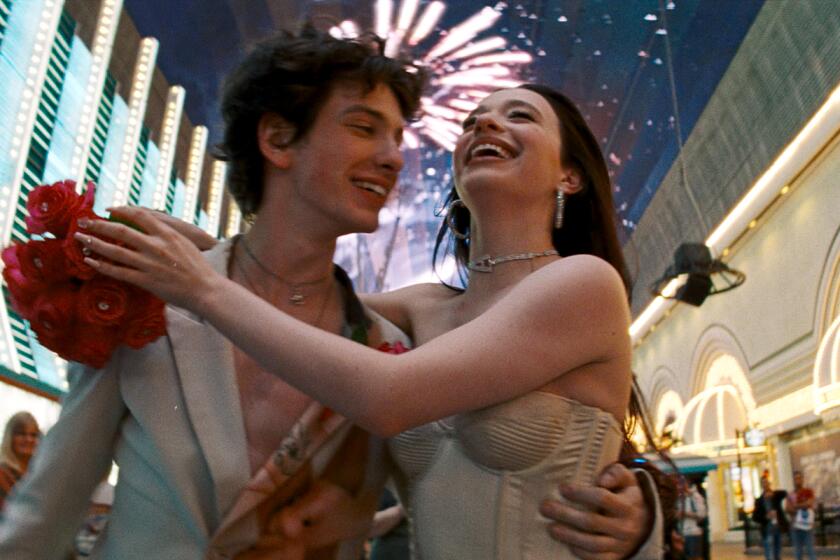What Hollywood Does Right for Disabled : Awards: Media Access honors those who promote the disabled on film and TV, but there are still few parts available to disabled actors.
- Share via
Wheelchairs lined the aisles of the Directors Guild of America auditorium for the 11th annual Media Access Awards, a ceremony to honor the projects and people promoting positive images of disabled people in film and television.
Among the productions honored Thursday night were the feature film “Rain Man,” a “20 / 20” segment on the musical comeback of disabled singer Teddy Pendergrass, “The Young and the Restless,” “Wiseguy” and “Designing Women.”
As award presenters talked and honorees gave their speeches, to one side a male-female duo signed for the deaf members of the audience, and clips of winning TV shows, feature films, documentaries and commercials were shown with subtitles on the 30-foot-wide screen.
The ceremony highlighted what Hollywood is doing right in portrayals of the disabled. But as some award-winners noted afterward, the festivities were set against a backdrop in which few parts in film and TV portray handicapped people, with even fewer parts available to disabled actors and actresses.
In a taped address, James Brady, the former presidential press secretary who was seriously injured in the 1981 Reagan assassination attempt, said: “Ever since I took a bullet in the head eight years ago, I have had to learn to talk again, to read again, to walk again. I have been successful. . . . We disabled people don’t want pity or sympathy. Instead, we want opportunity and fairness.”
This year marked the debut of the Harold Russell Award. Named after the Academy Award-winning actor in the 1946 film “The Best Years of Our Lives,” the prize goes to an individual who promotes disability awareness. The first award went, appropriately, to Harold Russell.
“There are 42 million disabled people in this country,” said Russell, 75, who lost his arms in World War II. “The media can’t ignore numbers like that. There’s a lot of progress being made. These awards are a sign of that.”
However, other actors said good roles are increasing, but remain few and far between.
“I’ve gone to interviews where I’m told I’m not disabled enough,” said Millicent Collinsworth, a blind actress who portrayed a self-defense instructor for the award-winning episode of “Designing Women,” titled “Stand and Fight.” What made that show so remarkable, she said, “was that the word blind was mentioned only once.”
Few disabled actors are given “real-people” roles, she said, in which a full character is presented. “Instead, it’s either quite angelic or embittered. Disabled performers want roles with real strength and purpose,” she said.
In fact, like many disabled actors, Collinsworth’s acting career has foundered since her “Designing Women” episode aired in December.
Nancy Becker Kennedy, an actress for more than two years on “General Hospital,” said she had to leave the show after a new head writer “didn’t know what she could do with a disabled character--and this on a show about a hospital.”
Other winners:
Individual achievement: James Brady, California Angels pitcher Jim Abbott, KCBS anchorwoman Bree Walker. Cece Robinson award: Paul Longmore. Public service announcement: “Wheelchair” by the National Easter Seal Society. Series as a whole: “TV 101” (CBS). Movie of the Week: “Bridge to Silence.” Comedy series: “Designing Women--Stand and Fight” and “Duet--Sister of the Year.” Dramatic series: “Wiseguy--Call It Casaba.” Children’s program: “Heart Dancing.” Daytime drama: “The Young and the Restless.” News magazine: “20 / 20--Once and Future Star.” Educational film: “Into the Mainstream” (PBS). Commercial: “Speech Writer,” an IBM speech program for the deaf. Outstanding contribution, individual: Betty Ford. Outstanding contribution, organization: Cox Cable System of San Diego. Special merit: “Friends Who Care” disability awareness campaign, NBC coverage of 1988 Summer Olympics.
More to Read
The biggest entertainment stories
Get our big stories about Hollywood, film, television, music, arts, culture and more right in your inbox as soon as they publish.
You may occasionally receive promotional content from the Los Angeles Times.










